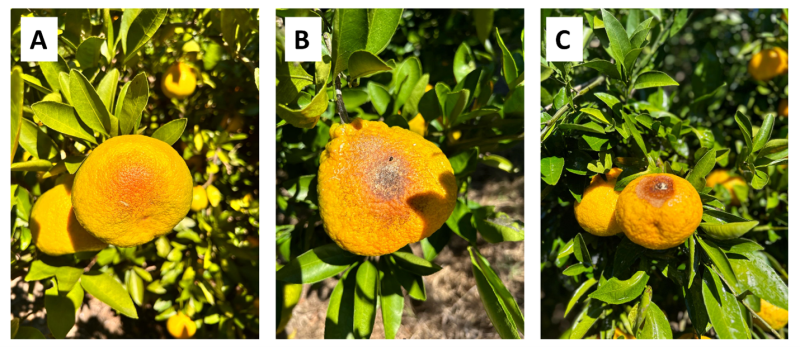Muhammad Adnan Shahid, UF/IFAS NFREC, Assistant Professor of Horticulture, and Shahid Iqbal, UF/IFAS NFREC, Postdoc Scholar, Horticulture Sciences
Introduction
Sunburn, also known as sunscald, is a physiological disorder in citrus and other fruit species caused by excess light and solar radiation affecting citrus trees, particularly during hot weather. This can lead to damage to the fruit, leaves, stems, and branches, resulting in yellowing, browning, and drying out of affected areas. Fruit exposed to direct sunlight are most affected by sunburn. This damage typically happens when temperatures rise above 95°F (35°C) and the sun’s rays are particularly strong. Young, tender foliage and fruit are more susceptible to sunburn.
–
Visual identification of sunburned fruit
Nowadays, consumers demand higher quality parameters for fruits and vegetables. Through good agricultural practices, farmers can not only increase their production but also the quality at harvest, which ultimately provides higher economic returns. Sunburned fruit tissues can become infected with bacterial and fungal pathogens, leading to pre- and postharvest diseases, including fungal infections, which may only appear once the fruit is on the market shelf. Identification of sunburn on citrus fruit can be done through visual inspection, as the symptoms are typically visible on the surface of the fruit. The symptoms of citrus sunburn vary depending on the severity of the damage and the part of the plant affected. Some visual sunburn on fruit is shown in Figure 1 below.

Figure 1. Visualization of sunburn on citrus fruit. (A) the start of sunburn (B) medium sunburn, and (C) severe of sunburn. Credit: Shahid Iqbal, UF/IFAS
–
Prevention and management strategies
Protecting citrus trees from excessive sunlight is key to preventing sunburn and improving the yield and quality of citrus. There are some strategies for the prevention of sunburn:
- Maintaining proper tree canopy by pruning to ensure adequate foliage cover.
– - Mulching around the base of trees to conserve soil moisture and regulate temperature.
– - Avoid excessive pruning during hot weather, as this can expose the shaded areas to direct sunlight.
– - Regular irrigation to keep the soil evenly moist, as drought-stressed plants are more susceptible to sunburn.
–
In summary, citrus sunburn presents significant challenges to citrus growers worldwide, impacting fruit quality, marketability, and overall orchard productivity. Through extensive research and practical experience, it’s clear that sunburn prevention strategies are crucial for mitigating its effects. Techniques such as proper irrigation, canopy management, and mulching have shown promise in reducing sunburn incidence. With proactive measures and continued advancements, citrus producers can minimize the impact of sunburn on their crops and ensure a more resilient and sustainable citrus industry for years to come.
- Boosting Citrus Cold Hardiness with Seaweed Extract Biostimulants - November 21, 2025
- Optimizing Nitrogen Use for Sustainable Blackberry Production in the Florida Panhandle - May 22, 2025
- Citrus Sunburn: A Physiological Disorder - May 17, 2024
